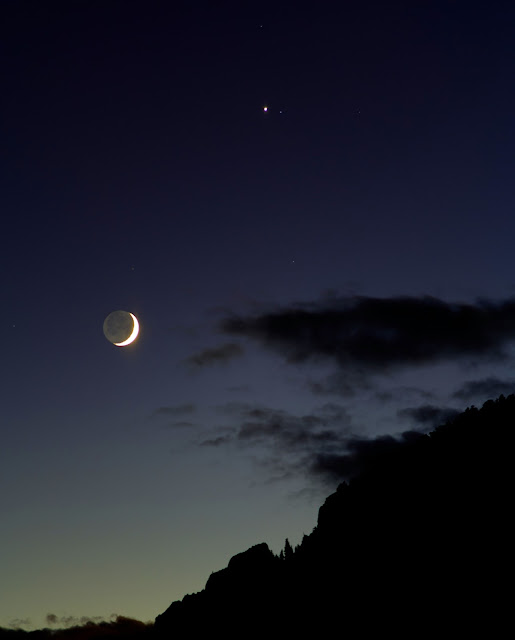A clear night before moonrise provided an opportunity to try out an old lens: a manual-focus Phoenix 19-35mm f/3.5-4.5 zoom lens with Olympus OM mount. This was designed for 35mm format ("full frame") and was purchased new in 2008. It is not an ideal choice for astrophotography because of the slow aperture, but it seems to perform surprisingly well for daytime photography (with some easily corrected lateral chromatic abberation), so I wanted to see how it would do at night. "Phoenix" is a marketing brand-name. According to speculation in old camera-forum posts, the OEM for this lens was probably the Japanese optical company Cosina.
The lens was mounted with an adapter on a Sony A7iii camera.
 |
19mm f/3.5 with Sparkle-6 filter. 6:34 pm MST.
|
In this image, Venus is the bright star in the lower left corner, setting over the ridgeline of Bristol Head. The bright stars Altair (left) and Vega (right) are just above center. Some bands of red and green airglow cross the middle and lower portion of the frame.
If you know where to look, Comet C/2023 A3 is still visible. The white circle in the next image shows the location. I was able to see it as a faint smudge with 10x50 binoculars. It is currently magnitude 8+ and fading.
 |
The white circle marks the location of comet C/2023 A3.
|
A longer-focal-length lens provides a better view:
 |
Comet and airglow. Olympus E-M1iii + 75mm f/1.8 lens.
|
The comet is in the upper left of the frame. The star cluster in the center is IC 4756, and the cluster to the lower right is NGC 6633.
 |
view toward the NW. 19mm f/3.5 + sparkle-6 filter.
|
The measured sky brightness after these images were taken was sqml=20.9 to the north and 21.1 to the south.
























.jpg)
.jpg)
.jpg)
.jpg)
.jpg)
.jpg)












